The Berlin Wall Memorial is one of the must-see locations in the German capital. Located in Bernauer Strasse, once a no-man’s-land of the formerly divided city, the memorial offers a unique insight into Berlin’s history. The historic site showcases the living conditions of the Wall era, featuring several information points -and also an entire piece of the Berlin Wall itself.
No other city worldwide suffered the Cold War’s consequences more than Berlin. The impact of the Wall sealed the fate of Berlin in the 20th century and its current social structure. Today the memorial at Bernauerstrasse offers visitors an opportunity to study history at the place it was written.
So, in this article, you’ll see photos of the Berlin Wall Memorial, accompanied by information for your visit. Moreover, I will share places you can explore close to the memorial to get a fuller experience. Finally, you’ll also find the best Berlin Wall guided tours to enhance your visit.
Let’s start.
*Some links are affiliate links. It means that if you buy something, I might earn a small commission at no additional cost to you.
Berlin Wall Memorial Guide: Information & Tips

Established in 1998 and dedicated to the people who lost their lives during the Wall era, the Berlin Wall Memorial is located at Bernauer Straße in the corner of Ackerstraße. Despite its size, the complex has various sections, and it covers each of them in depth. So, here’s what you’ll see at the Berlin Wall Memorial (German: Gedenkstätte Berliner Mauer).
A section of the Berlin Wall and the Death Strip

A big part of the monument is outdoors, and the remains of the Berlin Wall are the primary sight. Here you can walk next to the Wall and to what was formerly known as the Death Strip. Wherever pieces of the Wall are missing, they are replaced by steel rods to create a sense of continuity.
What was the Death Strip, though? The Berlin Wall consisted of two concrete walls with a 150-meter distance between them. The space between the concrete walls was the Death Strip. It was a place that no one could enter, full of barbed wire, watchtowers, and armed soldiers. Despite looking peaceful nowadays, it was a death zone once upon a time. Several people who tried to escape were killed on the Death Strip.
There are numerous information points throughout the Wall’s area where you can hear stories (available also in English) from people that lived during this time. Moreover, you can get plenty of background information about the Berlin Wall and how it destructed the whole city. The escape tunnels, the openings on the Wall, and the political insights will give you an excellent overview of the structure’s significance. This open-air museum is definitely one of the best things to see in Berlin.
The outdoor sections

There are four distinct sections to discover while walking through the outdoor exhibition. These are:
- The wall and the Todesstreifen (Death Strip)
- Destruction of the city
- Building of the wall
- “It happened at the Wall” (German: “Es geschah an der Mauer“)
The Reconciliation Church at the Wall Memorial

Concluded in 1894, the Church of Reconciliation survived World War II, only to be destroyed a few decades later. The division of Berlin took place in 1945, and the church became part of the Soviet sector. However, when the Berlin Wall was erected on the 13th of August 1961, the church’s position was problematic due to its proximity to the French sector, and in 1985 it was demolished. The official statement of the GDR (the East German government) was that its demolition would “increase security and order.”
The Church that you see on the site today was built after the Fall of the Berlin Wall. Of course, the goal was to commemorate the turbulent years and make a chapel that would respect the historical past. Straight before the entrance, you can also see the Statue of Reconciliation.
The documentation center
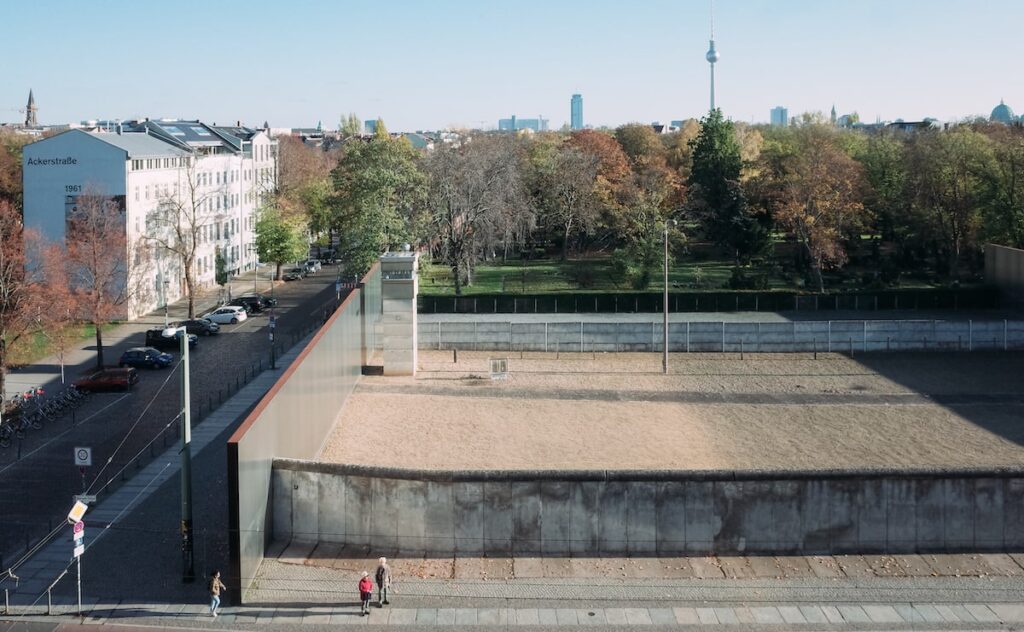
The documentation center lies on the opposite side of the Wall remains. There you can visit the exhibition “1961-1989: The Berlin Wall,” which is exclusively dedicated to the history of Berlin as a divided city. Rich in informational material, the center covers the political and historical context that drove the erection of the Wall. Moreover, it shows how the Berlin Wall fell and shares background info about Germany’s reunification.
Last but not least, one of the Berlin Wall Memorial highlights is the view from the center’s fifth floor. After climbing the steps (there’s also an elevator), you’ll find yourself on a veranda with a magnificent view over Berlin. In front of you, you’ll see the Berlin Wall remains, the Death Strip, and the outdoor exhibitions. On a clear day, you can enjoy Berlin’s skyline and see the Berlin Cathedral (Berliner Dom) and TV Tower (Fernsehturm), among other city highlights.
Other locations close to the Wall Memorial in Berlin
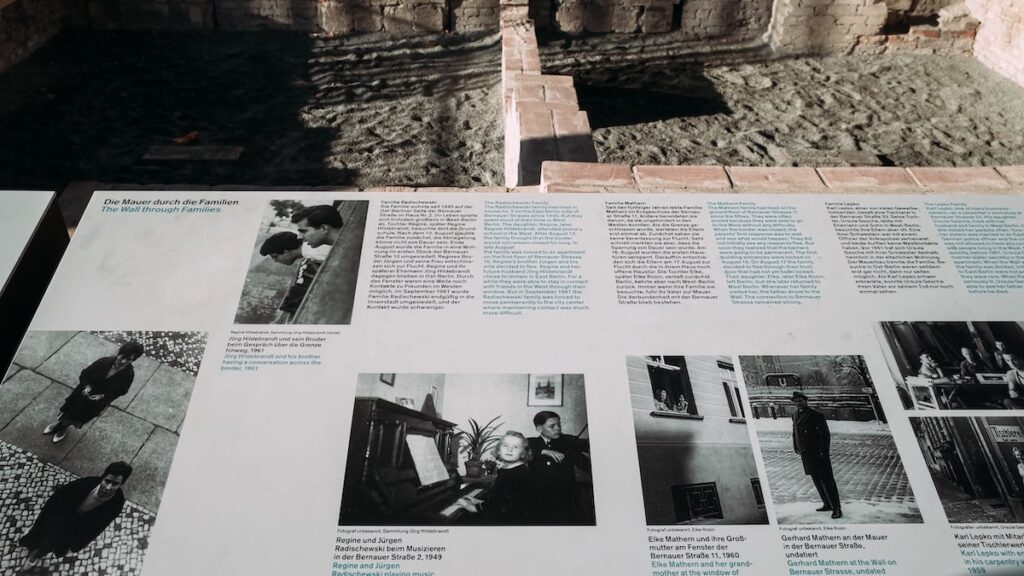
Although not technically part of the Berlin Wall Memorial site, there are two more locations just a few meters away from the complex. Both have significance; therefore, I thought of adding them here.
Nordbahnhof: a ghost train station
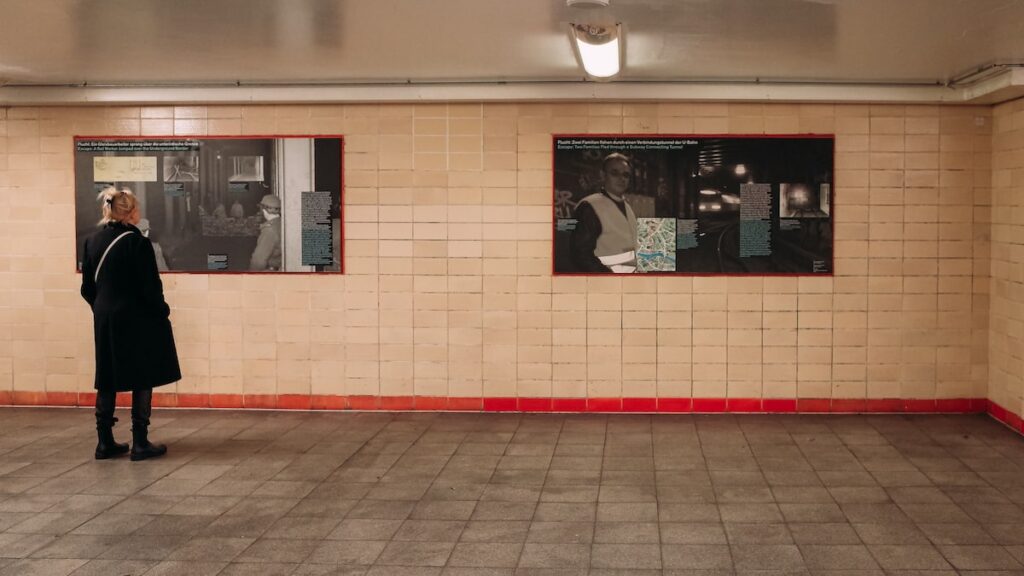
Just a few meters away from the Berlin Wall Memorial, you can reach the Nordbahnhof S-Bahn train station. Although today is just one more train station of Berlin’s extended public transport network, this wasn’t always the case.
A ghost station is practically a train station where trains would pass without stopping. During the Wall era, three train lines (U6, U8, and the Nord-Süd Tunnel of the S-Bahn) ran mainly through West Berlin but also had stops in East Berlin. Oddly enough, West Berliners could use these lines, but East Berliners couldn’t. Therefore, the stations in East Berlin remained shut, and West Berliners could travel through the eastern part on a train that didn’t stop. The term Geisterbahnhof was coined, and these places looked more like poorly lit barracks than train stations.
One such station was the Nordbahnhof, where nowadays, apart from regular S-Bahn services, you can see the exhibition “Border and Ghost stations in divided Berlin.” It contains original photos and footage from the era, and it definitely deserves a visit.
The Conrad Schumann statue
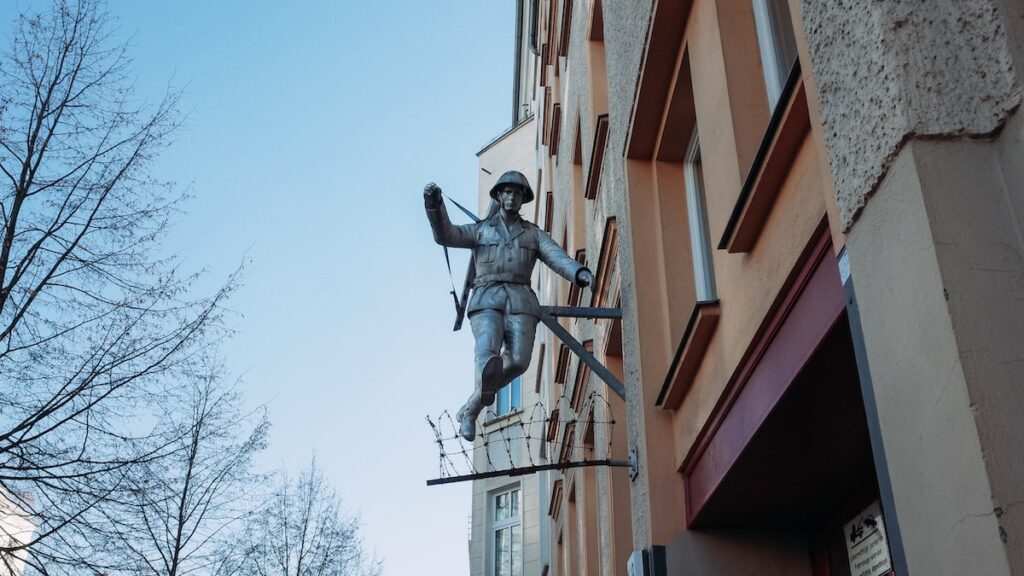
While this is just a small side story of the whole era, the photo of Conrad Schumann jumping over the barbed wire to freedom is definitely a nice add-on for your Berlin Wall Memorial visit.
While entering the outdoor area of the monument, you’ll see a photo covering the wall of a building. It depicts a soldier jumping over the wire of the Wall. The East-German border guard, Conrad Schumann, fled to West Germany during the Wall’s construction. On August 15th, 1961, the third day of the Wall’s construction, Schumann dropped his gun and jumped over to West Berlin. There he was picked up by a West Berlin police unit. It’s one of the most famous photos of this time, and you have probably seen it already.
Now, just a few meters from the memorial, at Brunnenstrasse 143, you can see a small statue with Schumann’s jump. The statue’s name is “Mauerspringer” or “The Wall Jumper.” Consider it as a nice, hidden extra of your experience.
Berlin Wall Memorial: Opening hours & more

Here you can find the opening times for the historical site of the Berlin Wall Memorial at Bernauer Straße.
Outdoor exhibition: from Monday to Sunday, from 8 am to 10 pm.
Documentation Center: from Tuesday to Sunday, 10 am to 6 pm.
Ghost Station exhibition at Nordbahnhof: the opening hours of the station.
Prices
Admission is free to all exhibition grounds.
How to get to the Berlin Wall Memorial
The Berlin transportation network is extended, and you can reach the Wall Memorial in various ways.
The easiest way to get to the Wall Memorial is with the U-Bahn U8. The stop’s name is Bernauer Straße, and you’ll be at the outdoor exhibition when you exit the station. Alternatively, you can take the U-Bahn U6 and stop at the Naturkundemuseum.
It’s equally easy to reach the memorial with the S-Bahn. Lines S1, S2, S25 and S26 all stop at Nordbahnhof. That said, you can start your Berlin Wall Memorial visit with the exhibition at the station before heading to the Wall remains and the documentation center.
Finally, tram M10 also stops at Nordbahnhof, and the same goes for bus 247.
Berlin tip: If the lines confuse you, I have you covered. You can visit the official website of Berlin’s public transport (BVG) and add your starting address. It can be your hotel’s address or any address in town. Then, add either “Bernauer Strasse” or “Nordbahnhof” at the destination and see the suggested itinerary. You can see the English planner of the BVG here.
The best Cold War tours in Berlin

In this section, you’ll find the best Cold War tours in Berlin. Several tour operators offer guided walks to the most important locations in the city that deal with the Wall years. These guided Berlin tours are an excellent opportunity to get local insights about life during the time of division. Of course, every guided tour you’ll find below stops at the Wall Memorial in Berlin.
So, here are the top Berlin Wall tours you can book right now.
Berlin Wall – Small group tour. That’s one of the top tours of the Berlin Wall. Apart from visiting various locations- like the Bornoholmer Strasse and the Mauerpark- you’ll also listen to real stories of families separated by the Berlin Wall. Of course, a visit to the Memorial is part of the tour. The prices start from 21 euros per person, and it lasts approximately 2 1/2 hours. You can book the small group tour here.
E-bike tour of the Berlin Wall. Berlin is a paradise for bikers, and if you enjoy cycling in foreign cities, this tour is for you. Your guide will drive you through Berlin and show you every iconic Wall location. There are plenty of stops on the way, and you’ll also see one of the nicest areas of Berlin while cycling. The tour lasts 4 hours and costs 41 euros per person. You can book the e-bike tour here.
Alternatively, if you use a regular bicycle instead of an e-bike, there’s a similar tour for the same price. You can book the bicycle tour here.
Fates, Heroes, and Love Stories – Walking tour. Finally, here’s one more excellent walking tour that deals with the Berlin Wall. A certified guide will walk you into the Wall Memorial and share plenty of stories about the Cold War era in the city. This guided tour is about real-life incidents connected to the 1961-1989 period of German history. You can book this walking tour here.
Bonus #1: A Berlin Wall extra experience
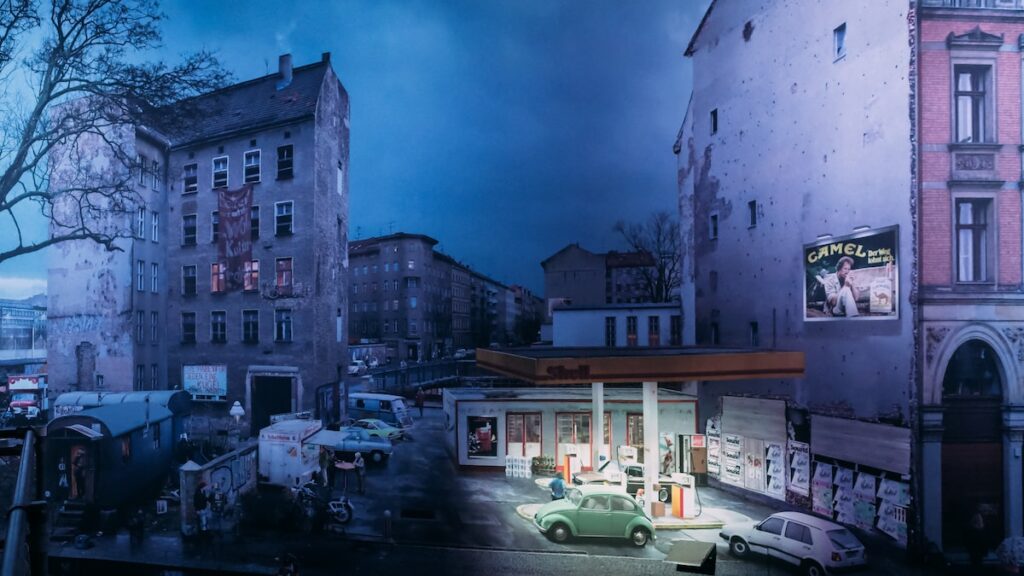
There’s an art exhibition depicting a day during the Cold War in Berlin. Artist Yadegar Asisi created a 1:1 Panorama close to Checkpoint Charlie, presenting a fictitious autumn day in 1980s Berlin. You can read more about it in my article about the Asisi Panorama here. And you can book your tickets here.
Bonus #2: Tilda Swinton with a Bike Around the Wall (1988)
https://youtu.be/RU_1nA332ws
If you want to see what the Berlin Wall looked like in the late 80s, here’s one of the most surreal videos you’ll ever come across. Director Cynthia Beatt follows with her camera Tilda Swinton as she rides her bike along the Berlin Wall. The movie “Cycling the Frame” is less than half an hour long, and some places Tilda Swinton visits are hard to recognize today. However, this is a 28-minute gem that will bring you back to the divided city.
Berlin Wall Memorial: conclusion
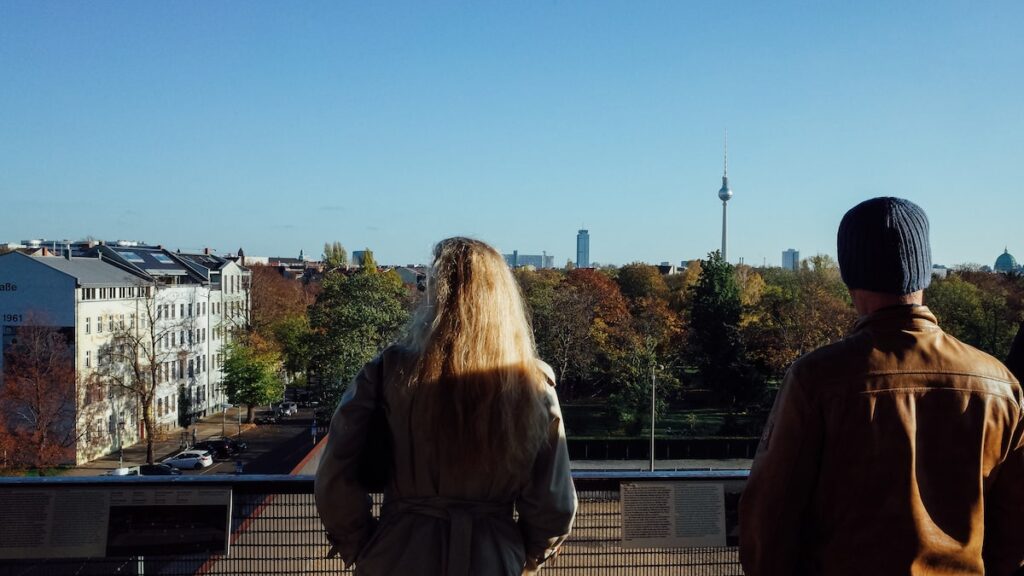
The former border strip at Bernauer Strasse was once a no-man’s-land; however, today is a place of remembrance where written history can be revisited. The Berliner Mauer no longer exists, but its traces can still be tracked in people’s lives. Nowadays, the Wall Memorial in Berlin attracts thousands of people every year, and it’s one of the city’s most iconic Cold War sites. Together with the famous East Side Gallery and the Checkpoint Charlie, it ranks among the must-see places.
Therefore, if you’re about to travel to Berlin, make sure to visit the memorial. Apart from a profound experience, it’s also one of the few places in Europe where you can immerse yourself in contemporary history.
More about Berlin: 3 days in Berlin itinerary, Berlin by bike guide, Berlinale guide, 10 Berlin facts
Pin it for later

Sharing is caring. Share this article about the Bernauer Straße Wall Memorial in Berlin with your friends.
Last Updated on October 7, 2023 by George Pavlopoulos

